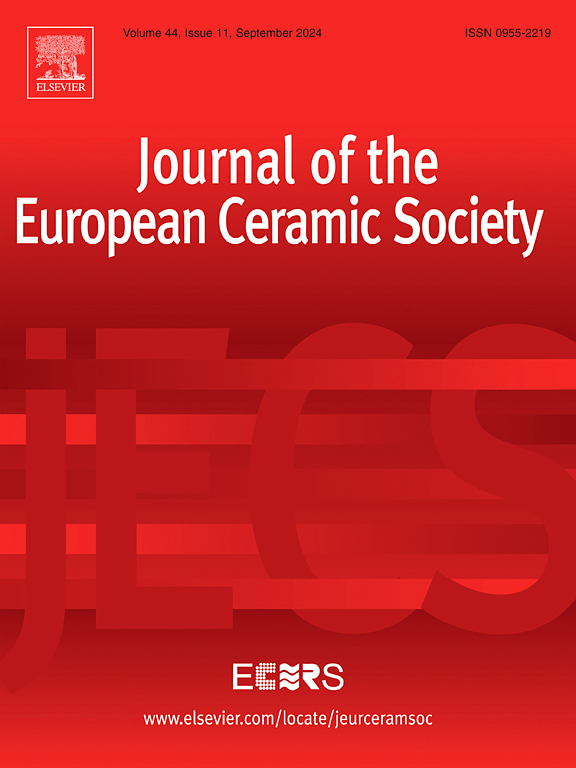Significantly enhanced photoelectric/photovoltaic performance in AgNbO3-based solid-solution ceramics
IF 5.8
2区 材料科学
Q1 MATERIALS SCIENCE, CERAMICS
Journal of The European Ceramic Society
Pub Date : 2025-03-15
DOI:10.1016/j.jeurceramsoc.2025.117371
引用次数: 0
Abstract
Anomalous photovoltaic effect of ferroelectrics is receiving intensive research interests. However, many ferroelectric materials struggle to effectively harness the solar spectrum due to their large bandgaps. AgNbO3 has partial visible-light response, but weak photoelectric/photovoltaic performance. Here, we prepare and report the photoelectric/photovoltaic performance of Ag1-xKxNbO3 solid-solution ceramics. The results indicate that all the investigated ceramics exhibit a narrow bandgap (Eg≈1.95 eV); mechanical polishing further improves light-absorption, enhancing photoelectric response. Composition-driven improvements in photoelectric/photovoltaic performance were observed, which is closely linked to the enhanced ferroelectricity. The poling electric-field effect on photoelectric/photovoltaic performance and ferroelectric properties reveals that the open-circuit voltage (Voc) and short-circuit current (Jsc) are directly proportional to the remnant polarization until the applied field reaches 100 kV/cm. Upon illuminating the polarization-saturated ferroelectric ceramic (x = 0.07) surface, the maximum Voc (=8 V) and Jsc (=1μA/cm²) were achieved, which are 10 times and 35 times larger, respectively, than those of AgNbO3 ceramics.
显著提高agnbo3基固溶陶瓷的光电/光伏性能
铁电体的异常光伏效应是目前研究的热点。然而,许多铁电材料由于其大的带隙而难以有效地利用太阳光谱。AgNbO3具有部分可见光响应,但光电/光伏性能较弱。在这里,我们制备并报道了Ag1-xKxNbO3固溶体陶瓷的光电/光伏性能。结果表明:所研究的陶瓷均表现出窄带隙(Eg≈1.95 eV);机械抛光进一步提高了光吸收,增强了光电响应。观察到成分驱动的光电/光伏性能的改善,这与增强的铁电性密切相关。极化电场对光电/光伏性能和铁电性能的影响表明,在外加电场达到100 kV/cm之前,开路电压(Voc)和短路电流(Jsc)与剩余极化成正比。在极化饱和铁电陶瓷(x = 0.07)表面照射后,得到的最大Voc(=8 V)和Jsc (=1μA/cm²)分别是AgNbO3陶瓷的10倍和35倍。
本文章由计算机程序翻译,如有差异,请以英文原文为准。
求助全文
约1分钟内获得全文
求助全文
来源期刊

Journal of The European Ceramic Society
工程技术-材料科学:硅酸盐
CiteScore
10.70
自引率
12.30%
发文量
863
审稿时长
35 days
期刊介绍:
The Journal of the European Ceramic Society publishes the results of original research and reviews relating to ceramic materials. Papers of either an experimental or theoretical character will be welcomed on a fully international basis. The emphasis is on novel generic science concerning the relationships between processing, microstructure and properties of polycrystalline ceramics consolidated at high temperature. Papers may relate to any of the conventional categories of ceramic: structural, functional, traditional or composite. The central objective is to sustain a high standard of research quality by means of appropriate reviewing procedures.
 求助内容:
求助内容: 应助结果提醒方式:
应助结果提醒方式:


